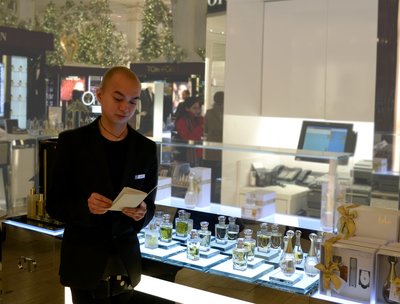NEW YORK - Students from Columbia Business School and Parsons The New School for Design’s interdisciplinary program “The Design and Marketing of Luxury Goods” worked with French atelier Christian Dior to propose a strategy that aims to build trust among consumers and sales associates in a retail climate where that relationship has begun to fray.
The team of students last week presented a proposal called “Enhancing the Dior Experience for Clients and Beauty Stylists” that offers methods for strengthening this vital relationship while improving the overall brand experience. Dior’s student team conducted extensive field research and shaped their proposal around the fashion house’s core elements.
“Dior’s story can be broken up into three simple parts so that the consumers can get the true feeling of the brand,” said Gabrielle Guglielmelli, a Parsons The New School for Design student and member of the Dior team, New York.
“The first part is the most important, that fashion and beauty were started at the same time and are completely cohesive together,” she said. “Secondly, these are the brand codes, everything within the brand has this: silhouette, cannage, houndstooth, flowers and, of course, color.
“Most importantly, the House of Dior wants to enchant the world and make every woman happy, feminine and beautiful.”
Team members from Columbia Business School included Amar Rai, Maria Carabas, Silvia Lousa and Alberto Tripodi. Team members from Parsons The New School for Design included Grabeille Guglielmelli, Divya Khandelwal, Daphne Vidalis and Jessica Walsh.
Enhancing the counter experience
The students looked closely at how Dior communicates its story to consumers as a starting point for their research. Next, the students examined the profiles and background information of both the consumer and beauty associates in specific retail locations to gain insights into the interactions between the two parties.
Since the consumer fuels in-store experiences, the team created a mobile application that elevates engagement through a rewards program based on spend levels. The app, staying true to brand codes by including the canache and pink and light grey, would give Dior a new way to interact with its core enthusiasts.
The team arranged Dior’s consumer base into four segments in the app. The bottom level is the “Cherie,” an entry-level consumer who buys beauty products but aspires to purchase more from the brand. The second tier is the “Beauty Maven,” a woman in her mid-30s who owns multiple Dior products, while the “Elegant Sophisticate” is slightly older and uses Dior premium products.
Dior’s fourth level of consumer was reserved for the loyal and higher-spending consumers. Each tier would have specific rewards giving the consumer a “window” into Dior.
Although the consumer’s experience was the top priority for the Dior team, they recognized that the sales associates had to be well-versed in the brand story. To ensure employee knowledge, the Dior team reassessed the brand's beauty training programs.

A Dior sales associate
To have a better understanding of a beauty sales associate’s role, the team attended training sessions required for Dior stylists. The team then reinvisioned Dior’s current trainee program to include fundamentals that could help the beauty sales associates with daily consumer interactions and in their overall careers.
The student’s training proposal included a six-week program divided into easily understood portions that the sales associate could then translate into clienting. The program would begin with an orientation where the sales associates would be given the materials needed to interact with consumers.
Within the orientation package would be a star-shaped pamphlet with key activities and information that helps the sales associate communicate with consumers. In addition, the program would issue a book detailing Dior’s culture, heritage and values for easy reference.
The program sees creativity as essential but also places importance on professional development through brand mentorship and advisors.
Re-building trust
In a retail environment that is constantly inundated with consumer reviews and readily available information, consumers no longer seek out the help of store employees as they once did. By implementing new strategies, brands can revive the relationship between sales associates and consumers.
A report by Forrester Research indicated that 66 percent of luxury consumers are more willing to interact with a sales associate equipped with a mobile device.
The “A New Generation of Clienteling” report discovered that some consumers do not feel that sales associates are the best source of product information. With the role of sales associates changing, bringing mobile technology into stores may help re-establish trust while creating an enhanced experience for consumers (see story).
Through the team's suggested program, stylists would become not just effective at enhancing consumer experience, but also brand ambassadors.
“The stylist remains the link between the brand and consumer,” said Amar Rai, Columbia Business School student and member of the Dior team, New York. “They are a key player in crafting brand image for the consumer.
“We proposed that Dior create a program that helps form a framework with healthy competition and collaboration and tailored experience so stylists are more likely to be loyal and want to remain working at the brand.”
Final Take
Jen King, editorial assistant on Luxury Daily, New York
{"ct":"ulWMTtUn5psfznBoEhX8xVI8aH5QJbIX69EZub\/RL28WNLsdpBl1Cje5E\/ik+ZM8iDpKDRFZkl4IW\/Hy\/Gq5LLC1DukPIQNXH0IRC3Jpm+4kKc+gaud8cFkEqZC0SSnHv5pRtTVUf7LascPpsEjh6bQyGmy9R2F4ctB3QS+SSVHdpgQEaU8+U66b016TJwr6l8U8+1bHMTrnNCuUB5Xzpx2v0Fu6+TTM95KECxgiPbiLyDeB4zOLUeCEsqGUVhvFuGp3ocjNon9BbIryw3MVgaFc\/svqBi9JY\/7OYhgY6ZN8xY6m1yTwlYbNZ4Wjy17sTzpQB9RQ0pfOB8Jw6ycUCiHcAsMWGAc8DChlY2lOY8zjvVjl9GE8S41gvjfcLLp+oWFKwjRtBqhRimsVT9kib\/PLHo\/aYxwI7i+qwgWW4toD9xfBxa7\/mGCUFBDFHECZyFkMQpvSI6QNiNaGTmUs26ZjN2idDqVEPoqeHZuZMrd2IMUtNOPtBWNMsTGNo6qscfTZ8hoKfwX5wdYXBbfOcNyWcpYIAOo4OJBVu5oGNVwrkOsxSdWmNctIzyOUmG7Yr2YOF6WJe\/+5oPAdfAW4IwNrvUlwgAhq8fYhrBb5e4xU8H4vHnqkBYojICgs1GhBIfknNGw6hiBctC3pRfvA3Nw9ccvZA76nCDrQEl+14FH26K0VZbHDArBrFQ7jpwHhTgdtgXhl9HSAzP3YVE1B0ryxbxoogLjOskwvHbMI87VAoOmucY+NDEJZ8g7zWeazqoaF3M3vZzRay7\/s\/SKqRS1r2tiJHUH9ebOiEAx4fu2LeJ+HuFjXfI3IwEWJpk0e31J0TjvuD4TRhUI0AEL\/z8KNO3QpcucwyIuMeSdL8EuRCyYg4EDeZlDVU5TXZIiaE\/tcjXyMFLNDxzzHJvnaFyzH2Ihhur1zREb+Jn+pmc53YGZqZJHCqJSzFnldXFXkTgLwBwA3eBoAJyQi6sBwqmEvOwm86dXud48AxLkHUVsWASAkQPxiw4J68v0sn14CgH9XBpMhKjm3Xp2Tjn9idSyBiM7X9PgSxAYkdXYavr5y0MC43EtvXRUhCTSAV+SWt+UIocxrcQ3MWt1dsWN2RD5cE82W6+4lP0zdgo\/9fIj8tJqFIBkfCEKmAar4+\/hHvVIztWDOBvNdUnsZVoIE+1R6UVydHOFdAMIPpkTHkpTHvSF78wRkBSWTv5DgpDEMxhh0TVokGRthC0Vt425SyFrj9XT7GQV1Y5nAliQoYKic+LOCFktS1GFB6tFPiu9D1U1SxwQbJiQlXbGlMB\/RdXkQ50+\/ptqv\/lVEjNL1x0lye5hyut1ZEFFs3RpwWWTE4rKIHwTQ6hTUV9juIcLT\/gCgGugdSYvhtOa+fsC\/Fn35oJrUsg93QJRsYd1ffSmeUkV8d7n078bitDRJOp7IcyweOJz1Y5Aot+mHjzv66xbnR2drL4bLGKKYEH4zG9NXUy9zyOibsi\/PBBK128P0qnsDfJodaEEb81qLpBGZF\/Qm4N6lYi0U1k7NHlbMMdPU8CrtkCztZocTyX9cHEJh5rM+J5n71YFSqq92C6T6FzVzK+Z6Nu8AR145O9R3WjVKIemiPsXQFhfcybyjjOrM3CHU\/N1E4Lydt2SxhWpkZxLdpj9SoffQVrCV3I0bW2HeMtr3t1MKXzd9uRoJ37tR6ST+ILHxOzrtwMW5sEHVQOxHNjm\/pqMCEHwj\/15Iqks6G+3OBX\/f0CzOCKRYrozSgQFwffE1yxTvZ4e5K5Y3lAHqyzdEcS5cDif5\/loeQ08xdvIzM4LUo1WNY+FFOFyuhkRKDrOOtesaRWTSRXaaQhm+5RPQ0hlipNap0A0Z00aiuapcK2mdBlWT0ujnFFxaky3uIliuj6SCcZhGt1s744czNJHZQLi2i4+lmo\/HlpCbVKLRK77\/NGvqDBTSMpCJeGSp5vM438x5zR5sFBx6pZ6EioqpPjKo3JYCBXq6CUDwS26ig92LU4yQb99tSL1DwzqQeTiLNxccXiPCjBx+fIXVgDXRu\/lXTGc4lCeYgwfBelczEsiLQhrnDbk9n0ZtyrmMekt\/Fbrf8PWvlveh0ubnjr+qLRBIBH6tpmAw6UCZUCRPRAA\/58CLd2QVGvtOuJZjDZ7a9UcePcAQBwf32TXrO57SamwpuT49Lz98QNyT0Y3Z4UvDyhb4eJiQ38iIC8VIxWLmSN4mhOBBjxL7w0Ew5UeauWD16Uuc4BpPoCO5PguwG4pIxN1FSpkmIHxbdFxv3jDWr+D8Kp+ZB9RJOddvAKKCl3\/sw1IbsT3\/QQU3k8HGi8UXvt8MSrPOj9NeAl\/lNaGJRfwX1TX3BoR0patmA4mG9IZ5JSal8\/yPJpeloU9sM0\/LWAbToe4CYm0zuIZMHoWgBdu1yNFsNBu1CiaMtBjgqo4cKMe9Xfku\/\/jfwyWok7oMecauYIGgRcrka3Awvs9z52ncgWSXAB6TqTQaPB10rwZj\/ziKbJf22na7FYtA6IHzFqOFthDSnwNPZr8joyCGUsE2dAY2Uztpu8mZ3SwZ75chcnIR74MGZsXP9f0mvucUNSlnuJ7BJlqjcGgyCQg2OaI3LS9YgQc0CW7s0yR0\/qc4en9NZNq2Q0FrNtOaDho2Fa9DPxcXP1TlRhrAfJ8gEfFhuhQUQDtJ8GNUML9qfT1LeYeQB9lqy1BpKa34EwjxYXHeZIWFbNmedxG8mmS3JfflAzbg6ukMJVsHzNxmZFhQ3CXP0CbWuhh2tCqN78L4UY8J2znK5\/TQpINdK6vr\/D3M8XeuPoLb\/lIIonyesrt2q\/ogWVoIYHAtchxzw2uF80mKuCRkLXUQxlsIbzMctrnE0XynO3Af4TuuMOQy9iH0NwcoNaYPEgMGFGYRRxiqvWXqvS5+o5uA\/rv4B6NuekRQS9jcsvGLTWdoCSVMZ4q3o2sTGJmVE+wC3PARq5mrAeG1PhYJ8SVF4FxC2XOp\/ulJWyE4bbhK3yjENCrIBSQ4LZVJ\/JvWkpeugwMkTGtSYJ7VHKt+ISkAsFJnee\/NR\/kzUeSVbyD7sJMfi7yI6YQP\/m4qM2X6o8P40elIdKHTe2WmFP3BkxCbFBvIQbocA94ugRS3wGMW1KtIkhkHMudQbu5pLifgFa97Ti44AqsaD6PMIjCCqCpaqLhUI5EH9M7jG+onH5G43HwLcrFDiA7fAADUzUpTBkXMiTJrAhIQGwpMrtYpjfpMdy+h0gyA8hU+30GAHQ1Jg85Q3kebln+obncJfkKfeJzbU+pTdwYHNKndI\/R77LuTirnEKjyfMdmDdvkJoYsAlyWTujyBb19TjWf7irehS9hHM\/IwVelJFZHc3tCfwS4N3IZD3VRgNEjPxhut5Djinenak+KFiMh2RGioUQ7FVDuXtLUlLzsMDKrQzsXxKvwLALNzbWJgoouU9HnOJ85dW9DGrdRdznLRWbADi1ZIM72jXxbQs66vRSaLq5NCv6cpz6xT2nrXt+8UZdwl2QKcc5eq5ClmM3bgrXPoA05ngA7hsMNtwZdxkMnE88RD9PF7XGWsuNCLfFvTm\/U4ZK5JKwya6epgcgqgmI1lPZX\/W\/3rqNBX\/olbC2IR9dXZRAVKpoodFP\/6BrYwWFqXKB6pyCB\/l4HDoGySU+S5GhiMXsjEceFC7+CPHFh4oIAwmx4kYFBFDz5MuTMabElqIvjJFWml30xmIIuxOBcujyM0xRbzwBdPMp8ptHy05mWZWRJqNWZ1FNbkzd2n0lrdN2o2lKEHWFUlmhNLuvKlEb186PBQDr0Kir8m3\/oiAjllh1PH1BoqGrHKMRHprDZe2TFqo5IbZnYXUcxxdqyo+Lo+jzTW5OGSdTjm3ELWfZnmG21fY7r7R7CNB3LReliVh97Rxfti8imcj4\/MvdpsghfoAe4E65qtNh65tcRk+4dcm9vtxBegkcK6dcxarfqAkYyA77oEukzic668j51QtPNlu77SYIoLOXb7ToQ4kwX+IerqDsCyrSGSdSdXdSzUKWbWoHnnZvrzu8dlEdS6\/QYrgUuRrDm4cAO4\/yAQzhxtsZL1hepmPLVI+s52lYjaZPbWx8EIxAICtAUM46Vd2pAwI60AYO2YhwbPwW3k0bO3BNYsc4NG3rErnbQdRRp8LK\/dc4OCo7JzrKTodSEcEoeA+6P0MtrseHHjSR1b6IjoBMEnKenbFPrNt25OREIFoZb3Guq+elG7a5LODS3gkwgsjxdIIzyE\/CbtHys18LmgnhJvoq72QVsXkw35oXMqaryr13mvjHO5H\/Ht\/y3ZbuKma4tEKy58EBrMGBFqAAF6JqpPO7CVeUSznxqgjkeLKsuACVv9O3+Jk1i3994fam4Arg3jTcicbF3jf1uG9IOPtik8pkdPa2gGpdrcrLewzN9wlX+cONRikfVp3BTf\/cognmaFFSc+QX7xNOiO7wkssrFiV785WE+leIlkH5pWkZNoNsQZbvcRLIb5yuYiimAziQrJnf4sd3cb2FZAcv2\/QnqzasnpKchGizy8WojlUCWH6iozYC2C+QXL4TfdxI8SJOw7TJ2GVEvcN50eGzQOFxEBHNZivchhyK5Yks2Z4gbm678e3W73WdilTYaPC7rxMQ5XCIaDce1UxvKxikH0KWIlJwYnyU2SyeIPByjYOnyvG0DwnCQ02PjbL1IlKRpKdvefg6rwclqr1ihJLi6uxpYybmlSyaKu6NUCTF2YRlKtuCK8qU40zBK\/O25zj98CauDMj+3rTT7VkrTbXJNQdn+ZtWlCzUsEgxa0lWMFqv9+c6ZqTEQoGqdjNs31De6C1ONkbsDLQi+\/S+dkQQnW6JHFRkdGhrh7lDwE0K7abmrboO6ygh+FTUsuIUhNC\/Cfp1GJ5qGXvp489IrZ9m\/ucJXtSzyL1wEg5YOv13UEtug8VnJFNgEll9SdL3Mrp8YXljeHrp6jbhhRj3sra7mSS76IqrEj50+WWrEsc+XU+abCggNoa6mOXjxLp44KV2srYiofUygsd\/53SaPdd5xYYEBH4plikr21SbieDBxJxZDkQCTYhmEIA7LgmUvLZzIW2otSiq5J2iCBBfc6TzkOZ4KMZCAmwwe15uv+\/h5VZg97ERRaYgDYgSv82J7xkYaS9ZAyHccps3JgT2IHg0Yl4qoeu6+EVoZMYWte5WAQXnr8CLCAEMnVZVsy7tz9aGN3Xpw9gDXAffyXHXhDPAtUnw2dM2w67CPOYHBePOraCCNoW+3TeYf0rmB1xWqw8gV8BwerFsEJv0NYFk+O4jfO5WuMecQjIVxTRuX\/NxxcBDXvQfYU5mwP1TrmMdQ1P2OEqC9RfjXNJfuCiUuatMWtfZ2HJx9f2Sj7YRLsRutVhGujat8de727PFc3e3iS2Q\/tTDxxf73VomfGrvQyHgmKTe1eoKpZHoZ58\/2Ypuu3M8ywmSxgRvBsfu+tkazcCvzuIaRNomFLiVO2Nh8iataWzxJ8+yQGypXu1zhDD3FP+IExOEgGbKsMTcjxtaPQXfyOCIbAwsEM6VV6JGXizWUeeSK2vmq7ia9HyBJ\/zUeFVva42VSCJOPLifLUuu6kvYiYTCwg62UpT4meyLDiJMuVLBu4NQrgGun7BcJds\/nsdwCbBv0fbxHrD4SLlBBzN+Cc4CtB\/2cDKEW9IA1S2ozPcDHf75psbS01003ePFRoSPZmjpUZqhyrwj8ofvI4Mqeb21Hbr2Wd6kNT5NUCuv5ZhRVjbhTnhbiyAyH7g8\/AH\/QfDtWIfprYuL8OudJdn8exE65MkjE4IqkCU1tDfRWGWLYhvZUQ+HoHjmdgSjWDfeKiIjNHr23Lhbxg9kXw6rKJNIWGW60hJ0N8Nz+070sJOD9PvJgzezyvvYmli54EHL9yySNPbElKBFKRWO\/h8a5eZWXP6Fb1UuageT2f\/sKQszsk2bG9bsskLjmf2oM9yL7t3Vn3SO0366jTEAQPsIiqL3vA\/wwTlI7t47aNt7bIjKxArxOdKamBkCnojCviMSfZQwrwKV8TsDeBpTEB+HWY7zKlgsuLDKq0jLHX6bpIHwKw2RQsiFlOL7gb4vh82DC6EAJ77McwrQmdB6r\/v1lNfr4GE0xFfGwP7Xz8OGE8InUEZNQmZ9ihUVdM\/grsULAW3WD3OZBuXND0DgL6FqkuPuqwpk7v0KvfP87QHnxU13guETDo40Y3FHtiX5LcTq9GsRRQ3JZmkCYWQKTd7xhRszBWWKIK\/wItCpIGcoVzvdiNVbHBbkTjI4p73D2H9pp7USlbA\/hy95tlj5wF3ZPGcQsLTOQwhc97\/jcSJ7MaoPdKCWezONqPZhe0u0vSC8mHs55u4PaBqEq0FZ6w\/boflkg3kuNeZaYQFUE2DneJz5zDabaV7h3uCa14hfM6l96V1azkEveXnKtOXGvwSsbRCwiGqUp2fLEw0sH32z1RQ3YZwhh6jLlnysuzhVbMV7MPNp\/R7X0\/C+lLVP70yjPWA8ROskCVJpqWw0dar6zemjD7sYoYRHucL5gPSv8YgVoEiKRGK\/Txm5MJ47TheMeUCgH4K\/gKstSfr3XBUBsate1ulZMB0aJ+HH5p71PaZo4M8LoeJYRqATEapgRUoy7I19BkHWnUih64KTKPEe7iGbwNg60+vD06nW4Cu30QWcy9ADmHLqdicHI3zrXZ8+oIOhpcEHYXPaEf0NH8TkmRjGy2M1hJ59wrSqH4b+pBuyUyN5sTIJ2xs+stx8ntYh66\/TbETfbmBiab3Q8Z2R+qERl0z\/sUJk0UiNSKWQW42Bc\/bZc8iju05nZfGX7ZITJR0wLRcqb4DyBNZLSIzOKKwN9GcCpYhVCpW+GTGtXEy6fyBIK+FPOp9Ry5r8vZUFiGaF84FnuJgUEECxTu5pvZtSK6mmJjQo\/Dg3itODWyv70fxr7qU7aSxCJ70uMnjjfSub7dblyd1rxkxgq3RPysP7WW5hvDiBxCCjtVfN4FGnfhd7qCAlznC1CiuCU0Oj\/bWR6r8l2DhTE43NaohNMIy1Y7cqd+9kNnNTmN\/th3UCJ4sMYKrK+yjvsj4b5t7GCuohbhzMcncWCsQum1KUOexKKO5G6+EI\/ko0Lm5eo4k2DvNTTaU6VZb5BWlITldsCWFxAOQTP7kA9AMv1XKSEQPVQcifHS+A9261KlQC23YzSOmmtJGwRdhFiYRokaXMPFLmCptHopauQCeD6drZ2IuZBnUAc7DRxtJ4JddaYxih+P+lcYLLBJI++Gc2v19kjjngn+wz5WLa3GhfkMvEiYB27YBcn+LHh5VS2Jn9\/\/daqy17d8hRGwNqFQjAacinvak5qYj6nMrCZwFZ1nPiuFocgr49+kpzRIosf+Jc5pHbnARazdZH7odYmodVSLDB+TTtYN61WNuw7sVgrFXWIXW\/C2w53Vk41Zq1Uq3uodHyNScV\/t4c3mVwl4\/zURISkeR1q+A62jYr0DzCzFgYDF+sRoVx2LX+CKBpgejbzntERkYm2JQD830K4g+XB8Alf2GJbAp4jXs4YnFz7AiQAFKKztTEQRFmSxdum+Y6TCJne4n056f+4YQBZFjOx40xlvJhxO9zcyjmaFO8uTp+0J3Ymsy8wfZw+3M1v85Pqfzoj2\/neYRU8ouwTuf6iETX7UXR\/V0qZCDTFEy6+hO5AV7Z1SWOFwLesluwpYbP8i\/SLrBIEV8AOlPlVx114nQRF412XGBWqaRM0mXefKwIz42KgR+wZqfd81APl2wEC49EkkneLbMFPWw38ng5HuK8ZVkZvlMh2sVkMM77tapwjFx2KfS3baIphVgwJnEj8ftAJ\/WJahrSnpRnS+PX8QEBTaB7ebJOffSgPRmR1dSpTPShVw+yIVZKW04TONxD0+6z4ltBtvo6M8VO00Ki1ly2Q1L\/Z14V29uZ2a5fEIm0FA9qde2LgyyY1f51BElu42MgeB3h4KAa8pue9346QnxROaNmLKcEdwqWxaC+LWgmJsm8HNUk3YQozrKcJwHE+Yxg1xUE\/sYRt5zw2e6o6sQ1XTMvDP4w5Kn0A2A8SEiQam17TEnEd7H06XoqS4BcLFI0I4k7h7RioCyeWQ\/Gv9gJa0QR9RI+K3W6Ik\/QzEKeE\/KpVEA8edaMV2tRtecRF3ihs5tPVZv\/CC1lfQdPLNAgTvJP7byHhzuoFf8uR8hGmXopQWUOaVCzDoU3yAqwt\/aOdaSH0SbF+rDYXNOX5Jv0Ezr2U2gau1MS9f9E7R9AMJ\/KoarhLrn2PHHUsqTMNtPFc3ZkfxM22ptki44yzOwmdiLvKyTIAkybNeH3oSWCmO6bSoAxUfXiz4TYPJlhT5R71PAkxlkkWxbDZgn9LBT1n7mlekBp5h5f0jPZWnG1BKYUA1rsYIFk66qV\/KyazGQjV+yflQhzK1vVAIPpMf5j8CK4sVTTSZs7uyQ+zFgVPrE2NPsBLBFIGvQip\/Uc7IPqAq3jabx45wgvNaR0WIRjvybgTieh8W1zBWya0CsCmqtlwcNwFNlR7f6a6ZPfFtfZ6f89aMja\/Fglvld7LkOx9H\/DyFoM4bJ7Z4Oee4B\/LQlOSu63kIsoWqDiU1erOpNasU8ZuYuF4V7BG1i7zFJrBZV90wSndlMskHr0zPUQUsYdBRX7dYJ13XNuEOl\/2QQGIlyQKzfryVlHYJ6Oo1eeRCjtMFYoBA37EMNf5VUP\/kZU9DswrGwruLlOb35s4XoY5k\/3GNX1uaZIcucg152YiNm1q6C\/6PPOTd0mkvcv+0wI7ne8trz1C9kmY5LgpSBwPS9lSOuNQc1W2Bdbc92op44HX8++rKl+gMAScZ0uQH59P902BPFODhC8nzTB4ubqtWanlaydEW9D4CsTkyypWUI9N+lGH6JiK5zgBOjoSs0YTezl0ogJCjWBl3+8p\/6an7Wyic3ISU+ZoS7w\/ICKrCZy71p\/LOIhfoNGLlz\/9cXpMnEBHFRnxMifM8uViCeNdZcn1NEsRZvwU6HURn7cMXLSE+SYbGKIiJ+8iCEZtgw\/W\/gXFbCu7BHphGNoe2Mbr\/wsKICK50T2mS9oMB8StUiE80s3T8ZS4vbhi0dA4Tfy38giHgON7pMq41bq1OXQTWWIGIicVW98kavH1BtliiE2Pt+Zi0t4g+aJk0WlfgQlUpRMCdAgIyDBVhtQQYrDxdEXZFyQ9EUIhQunzXmdYtqMyzJofG9sTlQ90MZfVYpsZraqRX9qKWCbRbZIhaLl0xxwT0DoDQG2McmZihIgstUAxqcmqsGGdhlwNkE8tzvzoyqqnnvmacsWglSKnM+SX15YcXk2aRJv6Ce7HZ6TYGSJWMHIVjzY0iS9zODW6juoVKdtnAJw1+p7KgVAKOUh7xIs+ZgRP1KUGe3usWkpDLEjhds24Bd\/JVjowsFteEYcIxVaLqeGBD2qnFFOxu7CXTN93cpfznAS\/2CTDZT21crF9QY6bhqSDAva\/0zoWuLpjS2OaOtvkI0XTeJyRGh\/LSqnLAyMguFD9TfOYNgivZLGqDzVizb\/vTfK6LC1IA0Um+p45seDzmoQPPZYY9+UhuEDO3neigDkc0K7vreaFNzIfu","iv":"f8152694ec0781e042fba316f34bf1a5","s":"cc1d0b549d3c4a28"}
